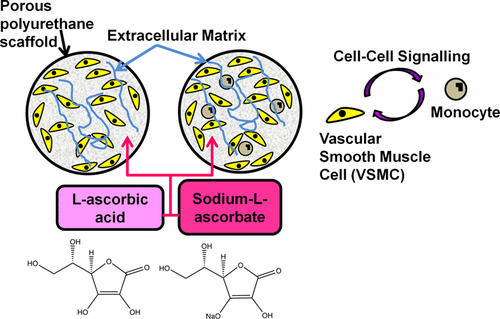当前位置:
X-MOL 学术
›
ACS Biomater. Sci. Eng.
›
论文详情
Our official English website, www.x-mol.net, welcomes your
feedback! (Note: you will need to create a separate account there.)
Differential Regulation of Extracellular Matrix Components Using Different Vitamin C Derivatives in Mono- and Coculture Systems
ACS Biomaterials Science & Engineering ( IF 5.4 ) Pub Date : 2017-11-02 00:00:00 , DOI: 10.1021/acsbiomaterials.7b00389 Xiaoqing Zhang 1 , Kyle G. Battiston 2 , Craig A. Simmons 1, 2, 3 , J. Paul Santerre 1, 2
ACS Biomaterials Science & Engineering ( IF 5.4 ) Pub Date : 2017-11-02 00:00:00 , DOI: 10.1021/acsbiomaterials.7b00389 Xiaoqing Zhang 1 , Kyle G. Battiston 2 , Craig A. Simmons 1, 2, 3 , J. Paul Santerre 1, 2
Affiliation

|
Vascular tissue engineering strategies using cell-seeded scaffolds require uniformly distributed vascular cells and sufficient extracellular matrix (ECM) production. However, acquiring sufficient ECM deposition on synthetic biomaterial scaffolds during the in vitro culture period prior to tissue implantation still remains challenging for vascular constructs. Two forms of vitamin C derivatives, ascorbic acid (AA) and sodium ascorbate (SA), are commonly supplemented in cell culture to promote ECM accumulation. However, the literature often refers to AA and SA interchangeably, and their differential effects on cell growth and ECM molecule (glycosaminoglycan, collagen, elastin) accumulation have never been reported when used in monoculture or coculture systems developed with synthetic three-dimensional (3D) scaffolds. In this study, it was found that 200 μM AA stimulated an increase in cell number, whereas SA (50, 100, and 200 μM) supported more calponin expression (immunostaining) and higher ECM accumulation from vascular smooth muscle cells (VSMCs) after 1 week in the degradable polar hydrophobic ionic polyurethane scaffold. The influence of AA and SA on ECM deposition was also studied in VSMC-monocyte cocultures to replicate some aspects of a wound healing environment in vitro and compared to their effects in respective VSMC monocultures after 4 weeks. Although 100 μM SA promoted ECM deposition in coculture, the condition of 100 μM AA + 100 μM SA was more effective toward enhancing ECM accumulation in VSMC monoculture after 4 weeks. The results demonstrated that AA and SA are not interchangeable, and the different effects of AA and/or SA on ECM deposition were both culture system (co- vs monoculture) and culture period (1 vs 4 week) dependent. This study provides further insight into practical vascular tissue engineering strategies when using 3D synthetic biomaterial-based constructs.
中文翻译:

在单培养和共培养系统中使用不同的维生素C衍生物对细胞外基质成分的差异调节
使用细胞接种支架的血管组织工程策略需要均匀分布的血管细胞和足够的细胞外基质(ECM)生产。然而,在组织植入之前的体外培养期间,在合成生物材料支架上获得足够的ECM沉积对于血管构造仍然具有挑战性。通常在细胞培养中补充两种形式的维生素C衍生物,即抗坏血酸(AA)和抗坏血酸钠(SA),以促进ECM积累。但是,文献中经常将AA和SA互换使用,当它们用于由合成三维(3D)开发的单培养或共培养系统中时,从未报道它们对细胞生长和ECM分子(糖胺聚糖,胶原蛋白,弹性蛋白)积累的不同影响。脚手架。在这项研究中,发现200μMAA刺激了细胞数量的增加,而SA(50、100和200μM)在降解后1周后支持了更多的钙蛋白表达(免疫染色)和更高的ECM从血管平滑肌细胞(VSMC)的积累极性疏水离子聚氨酯支架。在VSMC-单核细胞共培养物中,还研究了AA和SA对ECM沉积的影响,以在体外复制伤口愈合环境的某些方面,并比较了它们在4周后分别在VSMC单培养中的作用。尽管100μMSA促进了共培养中的ECM沉积,但是100μMAA + 100μMSA的条件在4周后对增强VSMC单培养中ECM的积累更为有效。结果表明,AA和SA不可互换,AA和/或SA对ECM沉积的不同影响均取决于培养系统(共培养与单培养)和培养时间(1对4周)。当使用基于3D合成生物材料的构造时,这项研究为实用的血管组织工程策略提供了进一步的见识。
更新日期:2017-11-02
中文翻译:

在单培养和共培养系统中使用不同的维生素C衍生物对细胞外基质成分的差异调节
使用细胞接种支架的血管组织工程策略需要均匀分布的血管细胞和足够的细胞外基质(ECM)生产。然而,在组织植入之前的体外培养期间,在合成生物材料支架上获得足够的ECM沉积对于血管构造仍然具有挑战性。通常在细胞培养中补充两种形式的维生素C衍生物,即抗坏血酸(AA)和抗坏血酸钠(SA),以促进ECM积累。但是,文献中经常将AA和SA互换使用,当它们用于由合成三维(3D)开发的单培养或共培养系统中时,从未报道它们对细胞生长和ECM分子(糖胺聚糖,胶原蛋白,弹性蛋白)积累的不同影响。脚手架。在这项研究中,发现200μMAA刺激了细胞数量的增加,而SA(50、100和200μM)在降解后1周后支持了更多的钙蛋白表达(免疫染色)和更高的ECM从血管平滑肌细胞(VSMC)的积累极性疏水离子聚氨酯支架。在VSMC-单核细胞共培养物中,还研究了AA和SA对ECM沉积的影响,以在体外复制伤口愈合环境的某些方面,并比较了它们在4周后分别在VSMC单培养中的作用。尽管100μMSA促进了共培养中的ECM沉积,但是100μMAA + 100μMSA的条件在4周后对增强VSMC单培养中ECM的积累更为有效。结果表明,AA和SA不可互换,AA和/或SA对ECM沉积的不同影响均取决于培养系统(共培养与单培养)和培养时间(1对4周)。当使用基于3D合成生物材料的构造时,这项研究为实用的血管组织工程策略提供了进一步的见识。











































 京公网安备 11010802027423号
京公网安备 11010802027423号